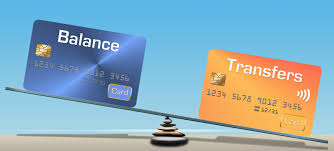Balance Transfer Credit Cards – Pros & Cons
Balance transfer credit cards can be a powerful tool to manage and reduce credit card debt, especially with the appeal of 0% introductory APR offers. However, like every financial product, they come with benefits and drawbacks that must be understood before proceeding. This guide outlines the pros and cons of balance transfer credit cards in 2025, includes real-life context, comparison tables, FAQs, and tips to make a smart choice.

Real-Life Story: How Sarah Used a Balance Transfer to Regain Control
Sarah was juggling balances on three high-interest credit cards, paying around 20% interest monthly. Feeling overwhelmed, she applied for a balance transfer credit card offering 0% APR for 18 months with a 3% transfer fee. By moving her debt to the new card and committing to monthly payments that paid down the principal during the introductory period, Sarah saved over $1,200 in interest fees and paid off her debt faster. She cautions others to avoid new spending and stay disciplined to avoid falling back into debt.
Pros of Balance Transfer Credit Cards
| Benefit | Explanation |
|---|---|
| Save on Interest | Introductory 0% APR for 12-21 months pauses interest accrual, reducing overall cost. |
| Consolidate Debt | Combines multiple credit card balances into one manageable payment. |
| Pay Down Debt Faster | More payment goes toward principal, speeding up debt payoff during the 0% APR period. |
| Improve Credit Score | Lowers credit utilization ratio by shifting balances; timely payments boost credit history. |
| Access to Better Terms | New card might have lower ongoing APR and better customer service than existing ones. |
Cons of Balance Transfer Credit Cards
| Drawback | Explanation |
|---|---|
| Balance Transfer Fees | Most cards charge 3-5% of the amount transferred, which adds to your debt upfront. |
| Temporary 0% Interest | Promotional APR expires after the introductory period, often reverting to higher rates. |
| Risk of More Debt | Without discipline, new cardholders may accumulate new debt on their old or new cards. |
| Credit Score Impact | Applying leads to a hard inquiry, temporarily lowering your credit score by a few points. |
| Credit Limit Restrictions | Transfer limits may not cover all debt; exceeding limits means partial transfer only. |
| Ongoing Purchases Interest | New purchases on balance transfer cards usually accrue interest immediately unless paid fully. |
Comparison Table: Key Features of Balance Transfer Cards
| Feature | Typical Range/Value | Notes |
|---|---|---|
| Introductory APR | 0% for 12–21 months | Limited time, requires repayment plan |
| Balance Transfer Fee | 3% – 5% of transferred amount | Can often be offset by interest saved |
| Regular APR | 15% – 25% after intro period | Depends on creditworthiness |
| Credit Limit | Varies, often covers most transfers | Check limits before applying |
| Additional Benefits | Cash back, rewards, no fee options | Some cards waive transfer fees |
Tips for Maximizing Balance Transfer Cards
- Calculate the Break-Even Point: Consider the transfer fee vs interest saved to ensure you will save money overall.
- Pay Off Balance During Intro Period: Make monthly payments high enough to clear the transferred balance before the 0% APR ends.
- Avoid New Purchases: Use another card or cash for new expenses to prevent interest charges during the intro period.
- Monitor Your Credit Limit: Ensure your balances do not exceed the new card’s credit limit.
- Maintain Good Credit Habits: Avoid missing payments or exceeding credit limits to keep your credit score healthy.
FAQs About Balance Transfer Credit Cards
Q: Can I transfer balances from multiple cards?
A: Yes, if the credit limit allows, you can consolidate balances from several cards onto one new card.
Q: Are balance transfer fees negotiable?
A: Sometimes issuers offer promotions with reduced or no balance transfer fees; always check current offers.
Q: What happens if I miss a payment?
A: Missing payments can void the introductory 0% APR and result in retroactive interest charges.
Q: How long does the 0% APR last?
A: Typically between 12 and 21 months, depending on the card.
Q: Will transferring a balance affect my credit score?
A: The credit inquiry may lower your score temporarily, but successful transfer and reduced utilization may improve it over time.
Conclusion
Balance transfer credit cards, when used responsibly, offer a valuable opportunity to reduce costly credit card debt and regain financial control. The interest-free introductory period lets you focus on paying down the principal faster, saving money on interest payments. However, they require discipline to avoid accumulating new debt, careful attention to fees, and a clear payoff plan before the promotional offer expires.
Call to Action
Before applying, assess your debt amount, credit limit needs, and repayment ability. Use online calculators to understand savings potential, and choose a card with terms aligned to your financial goals. With proper planning, balance transfer credit cards can be a crucial step towards debt freedom and improved credit health.
🇺🇸 Smarter Money Tips for Americans
Discover our guides on credit, loans, insurance, and savings designed for the U.S.
💡 Explore Guides